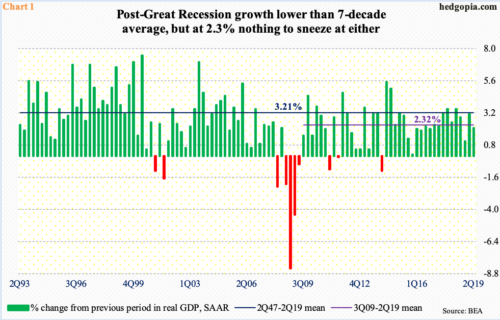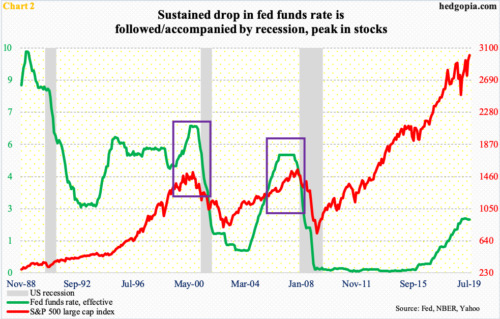Later today, the Fed will have cut its policy rate. Historically, this correlates with how both the economy and stocks perform – down.
Later today, the Fed will have eased – probably by 25 basis points, to a range of 200 to 225 basis points. After having gone up 225 basis points over four years, the fed funds rate has remained unchanged since last December.
Historically, rates are still low. Post-Great Recession, the business cycle just completed a decade. Signs of wear and tear are showing up, but, for the most part, the US economy is holding up. The first estimate of 2Q19 GDP was published last week, and it showed real GDP grew better-than-expected 2.1 percent. The average this cycle of 2.3 percent is much lower than the long-term average of 3.2 percent (Chart 1). That said, growth north of two percent is nothing to sneeze at.
Arguably, it is a little early for the Fed to be easing, particularly so as its monetary quiver lacks sufficient arrows. But markets are demanding it, and policymakers are going along. Considering the fact that the yield spread between 10-year Treasury notes and three-month bills remains inverted – which historically has preceded economic contraction – the collective wisdom of markets could very well be right in asking for stimulus. If they had their way, there will be another cut in September, and possibly another in December.
There will be repercussions.
A couple of things jump out in Chart 2.
One, a sustained drop in the fed funds rate sooner or later is followed by recession. The chart covers three contractions, and the phenomenon is particularly evident in the last two.
Two, once again focusing on the last two easing cycles, stocks begin to come under sustained pressure. This, of course, preceded massive uptrend, which is also the case currently. Just from the lows of last December, the S&P 500 large cap index is up north of 28 percent.
Here is the thing. If on the one hand it turns out the Fed does a ‘one and done’, markets, which are priced in for more than one cut, likely will revolt. On the other hand, a sustained drop in the fed funds rate did not bode well historically. As the adage goes, history does not repeat itself, but it often rhymes.
Thanks for reading!

